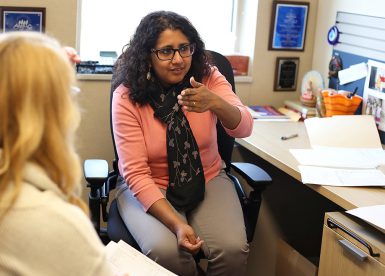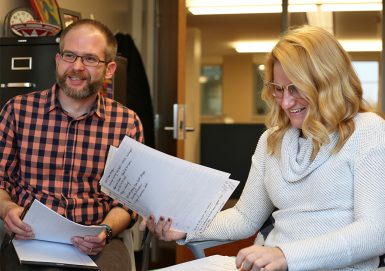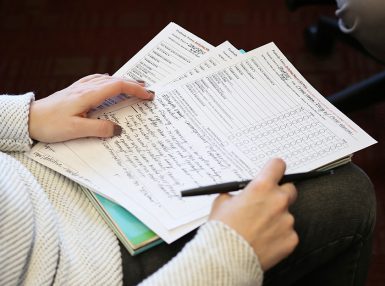Doc students, faculty judging Peabody Awards

Media School professor Radhika Parameswaran, along with doctoral students Rachelle Pavelko and Zach Vaughn, are applying their expertise as judges for this year’s Peabody Awards, which honor exceptional electronic media.
Over the next few weeks, they are assessing entries in the news category, looking at 23 stories to determine the best of the best. And when the awards are announced in May, they’ll know they played a part in the decision-making process.
“Judging gives us a wonderful venue to practice critical thinking skills,” said Parameswaran as she and her team met in her office for their first of three meetings. “It is nice to sit down with two scholars and ask, what do you think? We don’t get very many opportunities to do that.”
The team uses the Peabody organization’s criteria in addition to generating their own criteria, based on team consensus, to assess these entries. The organization formed in 1941 to honor radio stories that not only informed but also moved people to action or spotlighted an issue. The Peabodys later began including television, then web-based media. Today, it also considers streamed and other online content as eligible for its honors.
The Peabody Awards receive about 1,200 entries per year and enlists experts such as the school’s team to help with initial assessments. Those assessments are forwarded to the Peabody Board of Jurors, which meets three times before naming 60 finalists and 30 winners in news, entertainment, public service, documentary, children’s and web programming.

The organization invites scholars such as Parameswaran, who has judged entries in the past, to offer their insights and help narrow the number of entries for consideration.
Each of the school’s judges brings his or her professional expertise to the process. Pavelko is studying how mental health, particularly stigmatized issues such as Attention Deficit Disorder and Obsessive-Compulsive Disorder, are portrayed in the media. She is assistant editor for Black Camera film journal, a publication of the school’s Black Film Center/Archive that focuses on the understudied aspects of African American cinema.
Vaughn focuses his research on race, ethnicity and how marginalized groups are framed and how they choose to frame themselves. He is also a web manager at Framing the Global, an initiative of Indiana University Press and Indiana University Center for the Study of Global Change. It funds scholarly research that presents globalization and its effects and methods in a new way.
Both students were in Parameswaran’s course on globalization, media and social change.
“I knew they did good work, and I wanted the chance to work with them again,” said Parameswaran of her choices for judging partners.
Both Vaughn and Pavelko saw IU as their best choice for doctoral degrees in their fields as well as a place for opportunities such as this Peabody project. They said they were not surprised that the Peabody organization would seek assistance from The Media School.

“The doctoral program here is well known,” said Vaughn, who came to IU after completing his graduate degree at Ohio University. “It is known for the quality of the faculty and its variety of different academic disciplines.”
Pavelko came to IU after completing her graduate degree at University of Memphis.
“Coming here gave me exposure to diversity and allowed me to see different cultures,” she said.
“We all have such different backgrounds,” said Parameswaran, who is from India. “But when we deconstruct the news, it brings people together with a common goal. Research is always a sea of cultural diversity.”
The team uses these different perspectives to analyze the entries.
“We look at how reporters handle the narrative and the specific news gathering and reporting choices they make in portraying issues that are of concern to the public,” said Parameswaran of the first step. The team looks at sources the reporter used and if the reporter tried to get a variety of perspectives.
Vaughn said they also look at the “richness, quality and depth” of the story. Do they overpower their own stories? Is the story organic or is it too structured and forced?
The team also looks at the details of each story. Does the reporter use the same footage over and over? If there is music, does it carry the story along or does it sensationalize the story?
After the judging, the team will send comments and ratings for the best eight to 10 entries to the Peabody Board of Jurors. The board receives the input from media professionals and scholars from all over the country. Parameswaran describes the process as “tributaries” feeding into a big river like the Mississippi.

Although judging this number of entries based on limited criteria has proven to be difficult at times, these local judges said they have enjoyed the work they have done so far. Pavelko says being a judge has allowed her a “guilt-free way to watch the news.”
“This is not part of my regular routine,” said Parameswaran, who said she usually watches a select few outlets. “It’s a good way to be exposed to new media outlets.”
Vaughn said his favorite part of the judging process is the good journalism he’s watching.
“The ones that are exceptional are remarkably exceptional,” he said.
More:

